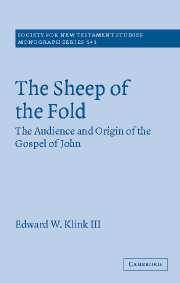Book contents
- Frontmatter
- Contents
- Acknowledgments
- List of abbreviations
- 1 The audience and origin of the Gospels: introduction and method
- 2 Early Christian community: a study of the community construct and its functional potential in early Christianity
- 3 Early Christian Gospel: Gospel genre and a critique of the two-level reading of the Gospel of John
- 4 Early Christian reader: an explication of the audience of the fourth Gospel by inquiring for the implied reader
- 5 Reading the fourth Gospel: the function of the Gospel of John in light of the Gospel community debate
- 6 The sheep of the fold: summary and conclusion
- Bibliography
- Index
1 - The audience and origin of the Gospels: introduction and method
Published online by Cambridge University Press: 22 September 2009
- Frontmatter
- Contents
- Acknowledgments
- List of abbreviations
- 1 The audience and origin of the Gospels: introduction and method
- 2 Early Christian community: a study of the community construct and its functional potential in early Christianity
- 3 Early Christian Gospel: Gospel genre and a critique of the two-level reading of the Gospel of John
- 4 Early Christian reader: an explication of the audience of the fourth Gospel by inquiring for the implied reader
- 5 Reading the fourth Gospel: the function of the Gospel of John in light of the Gospel community debate
- 6 The sheep of the fold: summary and conclusion
- Bibliography
- Index
Summary
Introduction
It has long been recognized that any study of the Gospels must incorporate to some degree a detailed understanding of the origins and traditions of early Christianity, whether explicitly or implicitly. The modern commentary almost always begins by discussing the introductory material before discussing the text proper. This approach is simply assumed. The end result is certainly affected in principle by the starting point. This is not to say that any understanding of the text is predetermined a priori and that the text itself is left helpless to the scholar's dissecting and analyzing tools; on the contrary, the text is often used as the very tool itself by which one draws theories by which it need be analyzed. Thus, any attempt to understand the Gospels and their meaning must consider thoroughly the means by which an understanding of what they are and how they came to be directly affects how one discovers what they mean.
The danger with the above is obvious: where one starts can undoubtedly determine where one will end. Too often a particular understanding of Christian origins can malign a text so that it no longer reveals the meaning most appropriate to early Christian belief and the text within which it dwells. In order to prevent such a mishap, it seems appropriate to step back from the detailed aspects of current research to see if the picture being painted by modern scholars is appropriately describing the texts as we now have them.
Information
- Type
- Chapter
- Information
- The Sheep of the FoldThe Audience and Origin of the Gospel of John, pp. 1 - 41Publisher: Cambridge University PressPrint publication year: 2007
